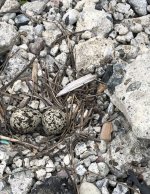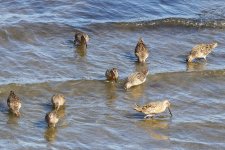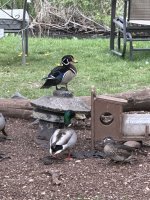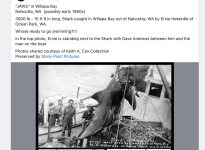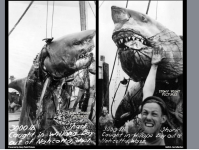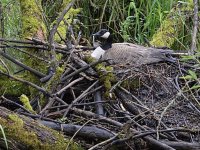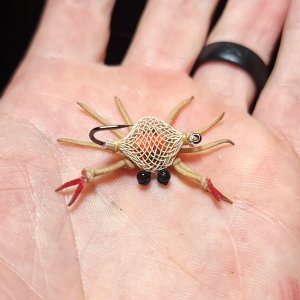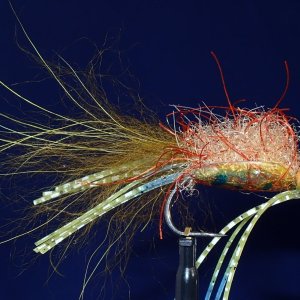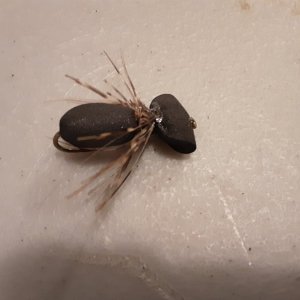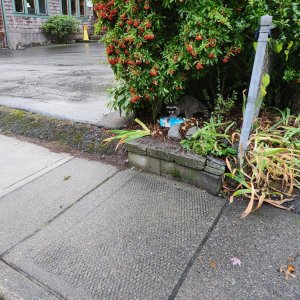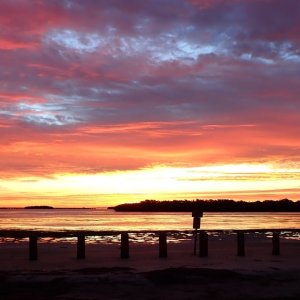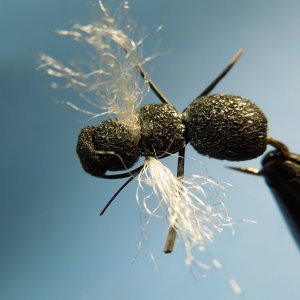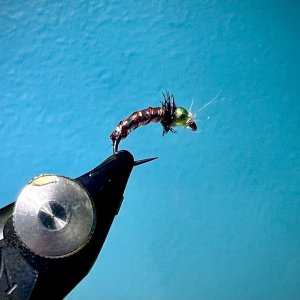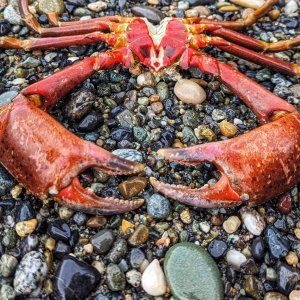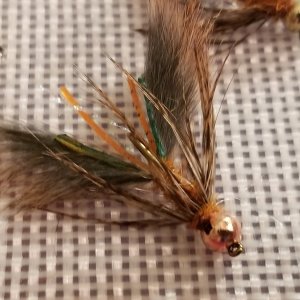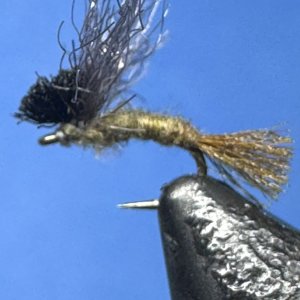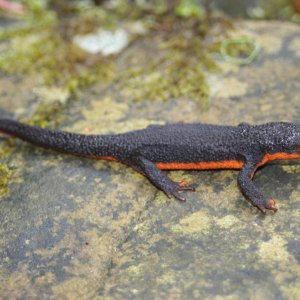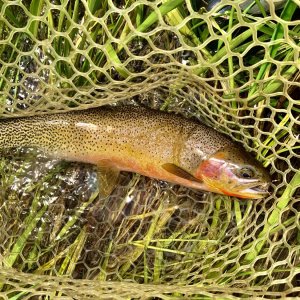Crappy picture or not, a nice find!
You are using an out of date browser. It may not display this or other websites correctly.
You should upgrade or use an alternative browser.
You should upgrade or use an alternative browser.
Got any bird pics?
- Thread starter Wadin' Boot
- Start date
Crappy picture or not, a nice find!
Thank you. I thought so as well.
Killdeer nest. It was right in the center of the gravel road I was walking on, fortunately one not traveled on too frequently.
View attachment 112161
We had a pair that would nest on our gravel driveway on the farm in Kansas - and then of course put on the injured bird display whenever we drove in or out, or walked down to get our mail - goofy things.
cheers
Tokeland has become a part of the birding loop that my wife and I take from Olympia to the coast via Bottle Beach State Park, Westport Marina, Westport Light State Park, and then Tokeland, (or reverse the loop if that works better with the tides). In fall and winter, we may add @Gyrfalcon22 ’s haunts at the Brady Loop Rd. if there is time. Our initial interest in Tokeland was derived from sightings of unusual migrants there that were posted last fall in eBird.
Tokeland sticks out as a peninsula into the north shore of Willapa Bay. The harbor sits at the transition between the more exposed sandy beach and mud flats of the bay. The area supports an active oyster mariculture industry. You can see great blue herons, marbled godwits, ring-billed gulls, and other shorebirds foraging among bales of oyster shells. The feathered food attracts bald eagles and peregrine falcons.
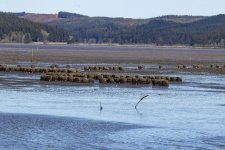
The same biological productivity that feeds the oysters feeds hordes of migrating shorebirds in fall and spring and overwintering species as well. These include short-billed dowitchers
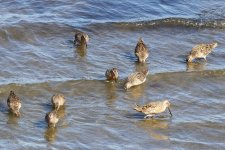

And least sandpipers.
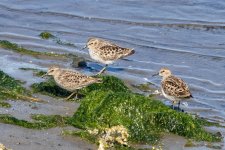
In the last visit, we arrived just after high tide to watch a steady stream of small flocks wing their way from the sandy beaches of the coast where they spent the high tide to forage the newly-exposed mudflats deeper in the bay
The outer edge of the harbor includes a wide breakwater that leads to a raised platform that is typically busy with crab fishers and a floating dock for transient boats and fishing boats. The elevated position of the raised platform provides great views of bird species diving in the channels, like this western grebe.
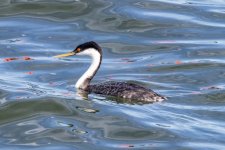
At lower tides, the pilings of the floating dock provide an opportunity to play “red light, green light” with diving birds. Typically, diving birds will only let you get so close, but when they dive you can reposition yourself to a closer distance. The pillars that support the floating provide some cover when the bird pops back up to the surface. A bird is less likely to swim off if it is handling food or interacting with other birds.
I played this game with horned grebes and captured a few nice images of this individual in breeding colors. You can see their common name is “horned” grebe.
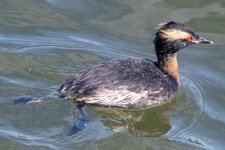
This one shows their “hex vision”.
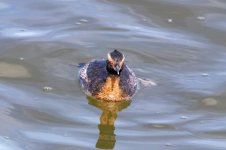
And lunch was bay pipefish, I think.
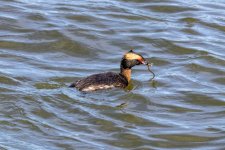
I used to same strategy to get close to some red-breasted mergansers. There were two pairs diving near the floating dock. [Extra points for a witty caption for what the female on the left may be saying.]
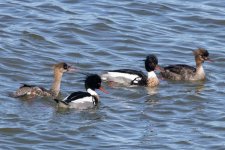
a hen,
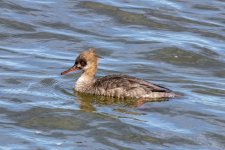
and a drake.
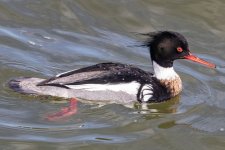
Steve
Tokeland sticks out as a peninsula into the north shore of Willapa Bay. The harbor sits at the transition between the more exposed sandy beach and mud flats of the bay. The area supports an active oyster mariculture industry. You can see great blue herons, marbled godwits, ring-billed gulls, and other shorebirds foraging among bales of oyster shells. The feathered food attracts bald eagles and peregrine falcons.

The same biological productivity that feeds the oysters feeds hordes of migrating shorebirds in fall and spring and overwintering species as well. These include short-billed dowitchers


And least sandpipers.

In the last visit, we arrived just after high tide to watch a steady stream of small flocks wing their way from the sandy beaches of the coast where they spent the high tide to forage the newly-exposed mudflats deeper in the bay
The outer edge of the harbor includes a wide breakwater that leads to a raised platform that is typically busy with crab fishers and a floating dock for transient boats and fishing boats. The elevated position of the raised platform provides great views of bird species diving in the channels, like this western grebe.

At lower tides, the pilings of the floating dock provide an opportunity to play “red light, green light” with diving birds. Typically, diving birds will only let you get so close, but when they dive you can reposition yourself to a closer distance. The pillars that support the floating provide some cover when the bird pops back up to the surface. A bird is less likely to swim off if it is handling food or interacting with other birds.
I played this game with horned grebes and captured a few nice images of this individual in breeding colors. You can see their common name is “horned” grebe.

This one shows their “hex vision”.

And lunch was bay pipefish, I think.

I used to same strategy to get close to some red-breasted mergansers. There were two pairs diving near the floating dock. [Extra points for a witty caption for what the female on the left may be saying.]

a hen,

and a drake.

Steve
Attachments
Gyrfalcon22
Life of the Party
Great job, Steve ! Tokeland is super cool, yet often my nemesis spot. Love the layout and really nice feel. Willipa bay is a gem. It has its share of neat sharks. 6 and 7 gill, and historically an occasional gill-netted great white.Tokeland has become a part of the birding loop that my wife and I take from Olympia to the coast via Bottle Beach State Park, Westport Marina, Westport Light State Park, and then Tokeland, (or reverse the loop if that works better with the tides). In fall and winter, we may add @Gyrfalcon22 ’s haunts at the Brady Loop Rd. if there is time. Our initial interest in Tokeland was derived from sightings of unusual migrants there that were posted last fall in eBird.
Tokeland sticks out as a peninsula into the north shore of Willapa Bay. The harbor sits at the transition between the more exposed sandy beach and mud flats of the bay. The area supports an active oyster mariculture industry. You can see great blue herons, marbled godwits, ring-billed gulls, and other shorebirds foraging among bales of oyster shells. The feathered food attracts bald eagles and peregrine falcons.
View attachment 112427
The same biological productivity that feeds the oysters feeds hordes of migrating shorebirds in fall and spring and overwintering species as well. These include short-billed dowitchers
View attachment 112428
View attachment 112431
And least sandpipers.
View attachment 112429
In the last visit, we arrived just after high tide to watch a steady stream of small flocks wing their way from the sandy beaches of the coast where they spent the high tide to forage the newly-exposed mudflats deeper in the bay
The outer edge of the harbor includes a wide breakwater that leads to a raised platform that is typically busy with crab fishers and a floating dock for transient boats and fishing boats. The elevated position of the raised platform provides great views of bird species diving in the channels, like this western grebe.
View attachment 112432
At lower tides, the pilings of the floating dock provide an opportunity to play “red light, green light” with diving birds. Typically, diving birds will only let you get so close, but when they dive you can reposition yourself to a closer distance. The pillars that support the floating provide some cover when the bird pops back up to the surface. A bird is less likely to swim off if it is handling food or interacting with other birds.
I played this game with horned grebes and captured a few nice images of this individual in breeding colors. You can see their common name is “horned” grebe.
View attachment 112433
This one shows their “hex vision”.
View attachment 112434
And lunch was bay pipefish, I think.
View attachment 112435
I used to same strategy to get close to some red-breasted mergansers. There were two pairs diving near the floating dock. [Extra points for a witty caption for what the female on the left may be saying.]
View attachment 112436
a hen,
View attachment 112437
and a drake.
View attachment 112438
Steve
The best birds always seem to be far out when I am there. I see shots like yours-the mergansers in close, and I wonder why I see them from 300+ yards? Same when the long-tailed duck or rare eider shows. If I am coming around they will all decide to hit the open bay. Here is a shot of a long-tailed duck that was so far out I did not even know I got a shot of it until later on the computer screen. Like 800+ yards.
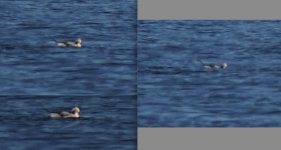
The female merganser in your shot is definitely channeling LeBron James (if anyone follows the NBA at all). Crying foul, or in this case, "Crying fowl"...
Last edited:
Gyrfalcon22
Life of the Party
I lucked out on the mergansers. The drake was almost too close. It helped that we were the only people on the dock at the time (no crab fishing folks tending their traps though there were traps in the water with lines tied to the dock).Great job, Steve ! Tokeland is super cool, yet often my nemesis spot. Love the layout and really nice feel. Willipa bay is a gem. It has its share of neat sharks. 6 and 7 gill, and historically an occasional gill-netted great white.
The best birds always seem to be far out when I am there. I see shots like yours-the mergansers in close, and I wonder why I see them from 300+ yards? Same when the long-tailed duck or rare eider shows. If I am coming around they will all decide to hit the open bay. Here is a shot of a long-tailed duck that was so far out I did not even know I got a shot of it until later on the computer screen. Like 800+ yards.
View attachment 112519
The female merganser in your shot is definitely channeling Lebron James if anyone follows the NBA at all. Crying foul, or in this case, "Crying fowl"...
Long-tailed ducks are a mystery. I have NEVER seen them close. I know a spot or two in the San Juans where I can reasonably reliably see them in winter from the ferry, but never close to shore.
Steve
Gyrfalcon22
Life of the Party
Red-breasted mergansers were equally common as Common mergansers 40 years ago locally. Not an easy find anymore.
Have a friend who had some very close shots of a spectacular drake long-tailed duck diving and feeding while looking straight down from a pier up north. As causal as a duck in a petting zoo.
I know my success rate of getting close to decent distanced birds has decreased greatly when using a monopod.
Have a friend who had some very close shots of a spectacular drake long-tailed duck diving and feeding while looking straight down from a pier up north. As causal as a duck in a petting zoo.
I know my success rate of getting close to decent distanced birds has decreased greatly when using a monopod.
Great pictures and commentary. Keep it up.
I was fishing a beach this weekend and noticed a lot of round holes in the sand in the upper tidal zone. The holes looked similar to what I've seen in the north sound when oystercatchers are around. Can't say I've ever seen any oystercatchers down there, but did see some sandpipers. The holes looked much bigger then the bill of a sandpiper. Do the bird experts here think those holes were from sandpipers or other birds? Sorry, should have taken a picture for reference.
SF
SF
Possibly, the holes indicated the burrow opening of amphipods, like the beach hopper Traskorchestia traskiana. They feed on seaweed or eelgrass that washes up on the beach.I was fishing a beach this weekend and noticed a lot of round holes in the sand in the upper tidal zone. The holes looked similar to what I've seen in the north sound when oystercatchers are around. Can't say I've ever seen any oystercatchers down there, but did see some sandpipers. The holes looked much bigger then the bill of a sandpiper. Do the bird experts here think those holes were from sandpipers or other birds? Sorry, should have taken a picture for reference.
SF
Steve
Possibly, the holes indicated the burrow opening of amphipods, like the beach hopper Traskorchestia traskiana. They feed on seaweed or eelgrass that washes up on the beach.
Steve
Thanks Steve,
These were pretty good sized holes. I'll take a picture next time.
SF
Through the winter, the marina at Westport has provided the perfect spot for many aquatic birds to enjoy shelter and abundant food. And because the birds become accustomed to the presence of humans, they can be approachable. The downside is that the marina is quite large. As the calendar forcefully moves into spring, some birds are changing into their summer finery in preparation for their migration to their summer homes.
I was fortunate to encounter a common loon that had already molted into its spectacular breeding plumage. It was diving in the cove just outside the breakwater and surface several times in solid camera range and with great lighting. [This could be the same individual that @Gyrfalcon22 showed us a few days ago.]
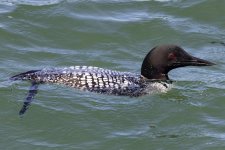
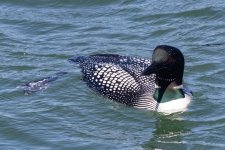
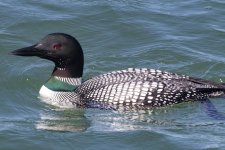
But there are still a few birds that haven’t gotten the message yet that it is time to "fancy up" and are still in their duller winter plumage
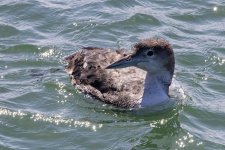
And it was still enjoying the bounty of the harbor, such as this crab.
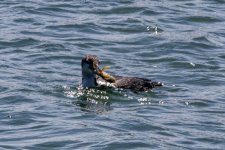
There are a few other “misfits” hanging around the marina. Long after the other surf scoters have migrated north, one lone drake remains.
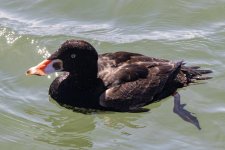
This drake has been hanging out with a lone white-winged scoter hen and a merganser hen (not pictured).
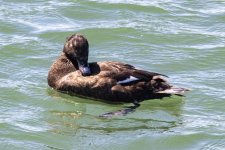
Other species have no intention of going anywhere. They breed locally and are perfectly at home in the marina. These include herring gulls,

pelagic cormorants,
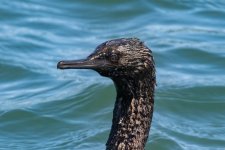
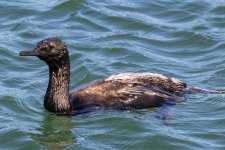
and double-crested cormorants. One grabbed a snake prickleback during a dive in the boat basin.
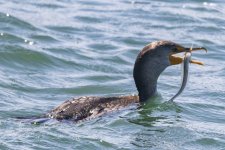 Another grabbed, tossed, and ate a young black rockfish just off the outer breakwater.
Another grabbed, tossed, and ate a young black rockfish just off the outer breakwater.
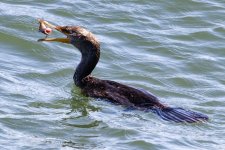
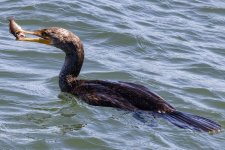
After being absent all winter, the first brown pelicans have begun to appear from their breeding grounds off Baja and Southern California
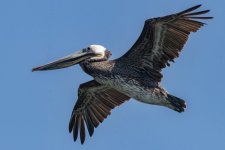
Steve
I was fortunate to encounter a common loon that had already molted into its spectacular breeding plumage. It was diving in the cove just outside the breakwater and surface several times in solid camera range and with great lighting. [This could be the same individual that @Gyrfalcon22 showed us a few days ago.]



But there are still a few birds that haven’t gotten the message yet that it is time to "fancy up" and are still in their duller winter plumage

And it was still enjoying the bounty of the harbor, such as this crab.

There are a few other “misfits” hanging around the marina. Long after the other surf scoters have migrated north, one lone drake remains.

This drake has been hanging out with a lone white-winged scoter hen and a merganser hen (not pictured).

Other species have no intention of going anywhere. They breed locally and are perfectly at home in the marina. These include herring gulls,

pelagic cormorants,


and double-crested cormorants. One grabbed a snake prickleback during a dive in the boat basin.
 Another grabbed, tossed, and ate a young black rockfish just off the outer breakwater.
Another grabbed, tossed, and ate a young black rockfish just off the outer breakwater.

After being absent all winter, the first brown pelicans have begun to appear from their breeding grounds off Baja and Southern California

Steve
Excellent, as usual, Steve.
This popped in my feed. Thought it was worth posting here.


Rare bird sighting in Oregon: Amateur photographer captures stunning images
A rare sighting of a blue rock thrush was made by an amateur photographer at the Oregon Coast. It had only been seen in North America one other time.
www.registerguard.com
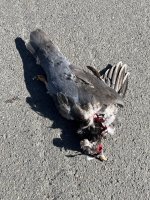
Sharp shinned, I guess. Just a little bigger than a pigeon. A crow was picking at it when I saw it, just in the street in my ‘hood. I wonder what got it or what happened? There wasn’t any other roadkill around like it was feeding and got hit by a car, but something else could’ve run off with it already. Also, this is a residential area and you’d have to be a real moron to run over a hawk here but…

